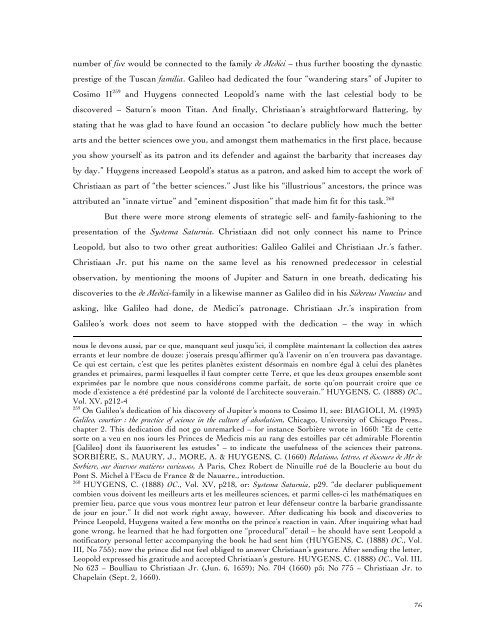Christiaan Huygens – A family affair - Proeven van Vroeger
Christiaan Huygens – A family affair - Proeven van Vroeger
Christiaan Huygens – A family affair - Proeven van Vroeger
Create successful ePaper yourself
Turn your PDF publications into a flip-book with our unique Google optimized e-Paper software.
number of five would be connected to the <strong>family</strong> de Medici <strong>–</strong> thus further boosting the dynastic<br />
prestige of the Tuscan familia. Galileo had dedicated the four “wandering stars” of Jupiter to<br />
Cosimo II 259 and <strong>Huygens</strong> connected Leopold’s name with the last celestial body to be<br />
discovered <strong>–</strong> Saturn’s moon Titan. And finally, <strong>Christiaan</strong>’s straightforward flattering, by<br />
stating that he was glad to have found an occasion “to declare publicly how much the better<br />
arts and the better sciences owe you, and amongst them mathematics in the first place, because<br />
you show yourself as its patron and its defender and against the barbarity that increases day<br />
by day.” <strong>Huygens</strong> increased Leopold’s status as a patron, and asked him to accept the work of<br />
<strong>Christiaan</strong> as part of “the better sciences.” Just like his “illustrious” ancestors, the prince was<br />
attributed an “innate virtue” and “eminent disposition” that made him fit for this task. 260<br />
But there were more strong elements of strategic self- and <strong>family</strong>-fashioning to the<br />
presentation of the Systema Saturnia. <strong>Christiaan</strong> did not only connect his name to Prince<br />
Leopold, but also to two other great authorities: Galileo Galilei and <strong>Christiaan</strong> Jr.’s father.<br />
<strong>Christiaan</strong> Jr. put his name on the same level as his renowned predecessor in celestial<br />
observation, by mentioning the moons of Jupiter and Saturn in one breath, dedicating his<br />
discoveries to the de Medici-<strong>family</strong> in a likewise manner as Galileo did in his Sidereus Nuncius and<br />
asking, like Galileo had done, de Medici’s patronage. <strong>Christiaan</strong> Jr.’s inspiration from<br />
Galileo’s work does not seem to have stopped with the dedication <strong>–</strong> the way in which<br />
nous le devons aussi, par ce que, manquant seul jusqu’ici, il complète maintenant la collection des astres<br />
errants et leur nombre de douze: j’oserais presqu’affirmer qu’à l’avenir on n’en trouvera pas da<strong>van</strong>tage.<br />
Ce qui est certain, c’est que les petites planètes existent désormais en nombre égal à celui des planètes<br />
grandes et primaires, parmi lesquelles il faut compter cette Terre, et que les deux groupes ensemble sont<br />
exprimées par le nombre que nous considérons comme parfait, de sorte qu’on pourrait croire que ce<br />
mode d’existence a été prédestiné par la volonté de l’architecte souverain.” HUYGENS, C. (1888) OC.,<br />
Vol. XV, p212-4<br />
259 On Galileo’s dedication of his discovery of Jupiter’s moons to Cosimo II, see: BIAGIOLI, M. (1993)<br />
Galileo, courtier : the practice of science in the culture of absolutism, Chicago, University of Chicago Press.,<br />
chapter 2. This dedication did not go unremarked <strong>–</strong> for instance Sorbière wrote in 1660: “Et de cette<br />
sorte on a veu en nos iours les Princes de Medicis mis au rang des estoilles par cét admirable Florentin<br />
[Galileo] dont ils fauoriserent les estudes” <strong>–</strong> to indicate the usefulness of the sciences their patrons.<br />
SORBIÈRE, S., MAURY, J., MORE, A. & HUYGENS, C. (1660) Relations, lettres, et discours de Mr de<br />
Sorbiere, sur diuerses matieres curieuses, A Paris, Chez Robert de Ninuille rué de la Bouclerie au bout du<br />
Pont S. Michel à l'Escu de France & de Nauarre., introduction.<br />
260 HUYGENS, C. (1888) OC., Vol. XV, p218, or: Systema Saturnia, p29. “de declarer publiquement<br />
combien vous doivent les meilleurs arts et les meilleures sciences, et parmi celles-ci les mathématiques en<br />
premier lieu, parce que vous vous montrez leur patron et leur défenseur contre la barbarie grandissante<br />
de jour en jour.” It did not work right away, however. After dedicating his book and discoveries to<br />
Prince Leopold, <strong>Huygens</strong> waited a few months on the prince’s reaction in vain. After inquiring what had<br />
gone wrong, he learned that he had forgotten one “procedural” detail <strong>–</strong> he should have sent Leopold a<br />
notificatory personal letter accompanying the book he had sent him (HUYGENS, C. (1888) OC., Vol.<br />
III, No 755); now the prince did not feel obliged to answer <strong>Christiaan</strong>’s gesture. After sending the letter,<br />
Leopold expressed his gratitude and accepted <strong>Christiaan</strong>’s gesture. HUYGENS, C. (1888) OC., Vol. III,<br />
No 623 <strong>–</strong> Boulliau to <strong>Christiaan</strong> Jr. (Jun. 6, 1659); No. 704 (1660) p5; No 775 <strong>–</strong> <strong>Christiaan</strong> Jr. to<br />
Chapelain (Sept. 2, 1660).<br />
76


